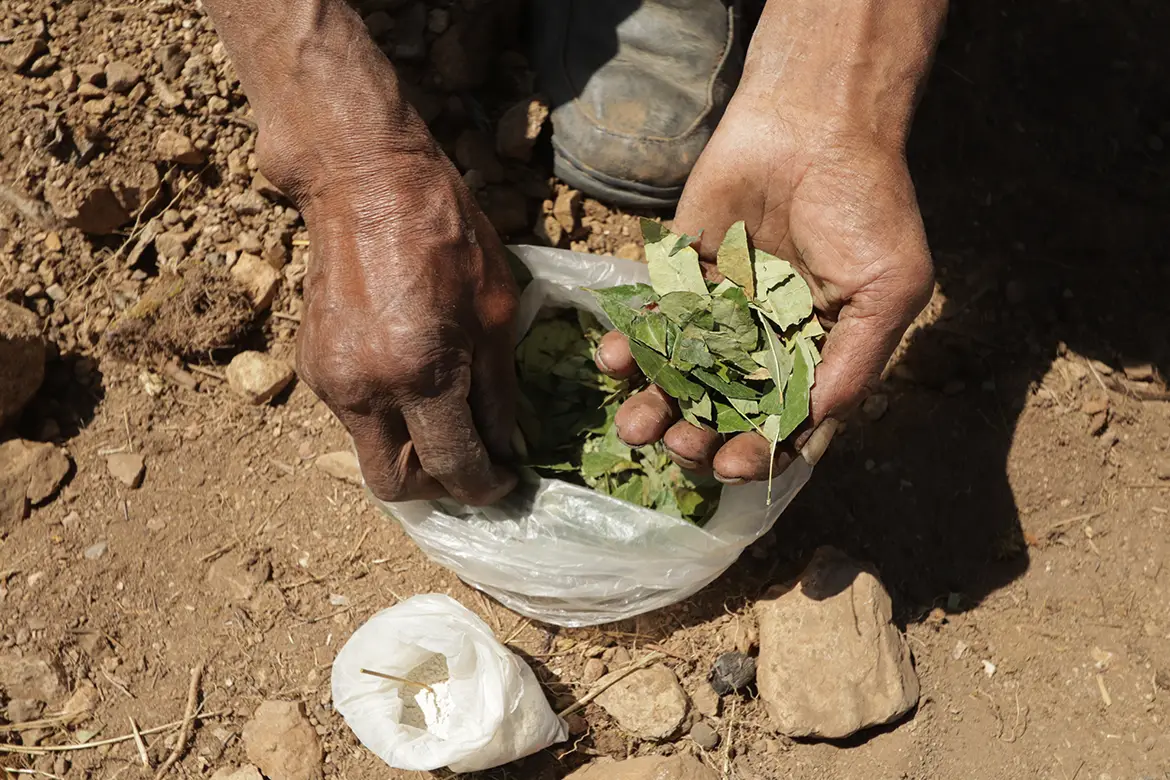Picture yourself on a hike, beads of sweat dripping down your face, the effects of altitude sickness overtaking your body—a slight headache giving way to chest constriction, body weakness, and pervading nausea—when you happen upon a tropical shrub waving in the breeze.
The shrub’s shiny red berries might catch your immediate notice, but it is the plant’s leaves, an unassuming green and tapered at the tip, that hold the cure to your many discomforts. When these leaves are dried and tucked into the pocket of your cheek or brewed into a tea, they not only alleviate altitude sickness, but also relieve pain, loosen period cramps, suppress appetite, and stimulate digestion, all while providing a source of iron, Vitamin B, and Vitamin C. You have happened upon the coca plant, or Erythroxylum coca, whose story begins far before its famous synthesized alkaloid—cocaine.

Andean lore traces the origin of this plant to a woman named Kuka, who, as legend has it, was sentenced to death by the Great Inca after exploiting her irresistible beauty for her own benefit. Her body transformed underground, breaking the surface of the earth as a vital plant that would bear her name, carrying the spirit of a woman who once energized so many men.
Some ancient and modern-day uses of coca include the addition of powdered lime, derived from seashells or the byproduct of burned, calcium-rich stones, which may make the alkaloids more potent or merely increase salivation. Lime containers—or “poporos”—unearthed in Colombia are adorned with nude figures and encased in gold, exhibiting the craftsmanship and care that surrounded the transport and ingestion of this plant. Containers made of seashell, discovered at a burial site in Las Vegas, Ecuador, are believed to be poporos and date back as far as 8850-4650 BCE.
Archaeologists have also found pre-colonial figurines with mouthfuls of coca, cheeks protruding outward, and pouches for carrying the leaves. In the era directly preceding colonization, the Incas set aside precious coca for religious rituals and the use of noblemen—some of the figures, sitting on stools, are thought to be shamans. In the postcolonial era, however, once Spanish landowners discovered the energizing properties of coca, they promoted its consumption among enslaved Indigenous people and its use became more widespread.
It wasn’t until the mid-1800s that coca leaves were synthesized into a white, odorless powder, dubbed “cocaine” by a German doctor named Albert Niemann. Two decades later, a Parisian chemist synthesized cocaine in the form of Vin Marian: a combination of Bordeaux and cocaine that even won over Pope Leo XIII, who is said to have carried the concoction around in a flask under his garments.

In North America, a war veteran named Dr. John Stith Pemberton would soon create an alcohol-free version of the wildly popular beverage using coca leaves and kola nuts, debuting his “Coca-Cola” as a “temperance drink” and an “intellectual beverage.” Advertisements from the time promised a valuable “Brain Tonic” for everything from headaches and hysteria to melancholy and “seminal weakness” for the impotent, but the legal proliferation and admiration of cocaine tonics would not last long.
How to Grow Shrooms Bundle
Take Both of Our Courses and Save $90!
After an era of sensationalistic, racist headlines associating cocaine use with violence, the federal government imposed tight restrictions on cocaine in 1914, criminalizing its import eight years later. The unprocessed leaves remain illegal in the United States to this day, in spite of the fact that it takes a full ton of coca leaves to produce one kilo of cocaine, with the two substances having vastly different effects. Most South American countries, on the other hand, do not prohibit the cultivation and use of the coca plant, where travelers to the Andes and locals alike can pick up a bag of mate de coca from vendors at outdoor markets and enjoy this mildly stimulating plant in its original form—the way humans have for millennia.

DoubleBlind is a trusted resource for news, evidence-based education, and reporting on psychedelics. We work with leading medical professionals, scientific researchers, journalists, mycologists, indigenous stewards, and cultural pioneers. Read about our editorial policy and fact-checking process here.

DoubleBlind Magazine does not encourage or condone any illegal activities, including but not limited to the use of illegal substances. We do not provide mental health, clinical, or medical services. We are not a substitute for medical, psychological, or psychiatric diagnosis, treatment, or advice. If you are in a crisis or if you or any other person may be in danger or experiencing a mental health emergency, immediately call 911 or your local emergency resources. If you are considering suicide, please call 988 to connect with the National Suicide Prevention Lifeline.



